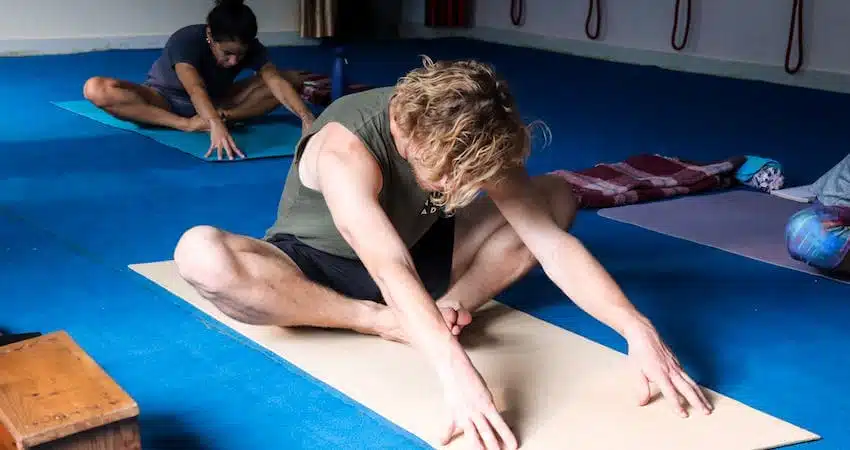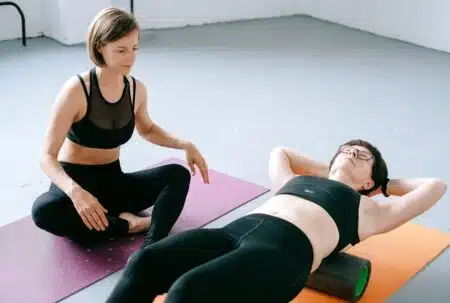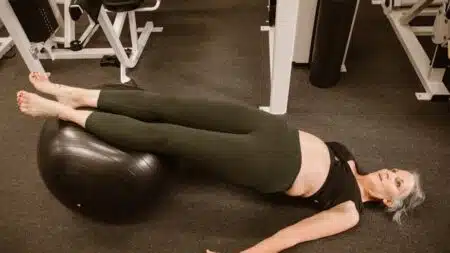Pain, discomfort, urinary issues. The culprit may be trigger points – hyperirritable knots buried deep in muscles like the pelvic floor. When activated, these tender spots produce local ache and referred sensations. By understanding what causes these trouble spots, how to find them, and proven ways to banish them, you can relieve discomfort and take back control. Keep reading to get the knowledge you need to tackle this overlooked source of pelvic floor disorders.
What are Trigger Points?
Trigger points are hyperirritable knots that form within muscles, often from repetitive strain, chronic tension, or direct trauma. These tender nodules produce local and referred pain when active. For example, trigger points in the piriformis can mimic sciatica.
Experts believe sustained micro-contractions of muscle fibers underlie trigger point development. Factors like poor posture, nutritional deficiencies, anxiety, and compression initiate this positive feedback loop.
As blood flow becomes restricted, inflammatory mediators and metabolic waste accumulate, heightening nerve sensitivity and muscle excitability. Nerves fire continuously despite relaxed appearance. This self-perpetuating cycle promotes stiffness, fatigue, restricted mobility, and strain.
Pinpointing Elusive Trigger Points in Pelvic Floor Muscles
The difficulty with pelvic floor trigger points is their buried location within muscle layers. Patients may report pelvic heaviness, painful sex, constipation, tailbone discomfort, or urinary urgency without identifying muscle knots as the culprit.
During an internal exam for issues like penetration pain or incontinence, a skilled pelvic floor physical therapist can palpate for trigger points. They may feel as taut bands deep in tissues. Pressing on them may recreate symptoms or referral patterns. Muscles resist stretching with limited mobility.
Though not routine, advanced imaging like ultrasound or MRI can visually confirm suspected trigger points when standard exams are inconclusive.
How Trigger Points Destabilize Pelvic and Postural Health
The intricate pelvic floor muscle web works in coordination with the diaphragm, abdominals, hips, and lower back to stabilize the spine and pelvis.
Imbalances readily spread throughout this kinetic chain. For example, chronically tight hip flexors from sitting can overactivate the pelvic floor. This strains tissues integral for bladder control, bowel regularity, sexual function, and tailbone comfort.
Conversely, a pelvic floor locked in contraction can tug the tailbone downward, influencing sacroiliac dysfunction and chronic low back tightness. Resulting posture stress adjacent joints, remodels connective tissue, and strains muscles forced to overwork – further ingraining dysfunction.
Alleviating Trigger Points Through Targeted Physical Therapy
The most effective approach combines manual therapy to disable contracted tissues with postural retraining and self-care. Hands-on modalities like myofascial release, trigger point release, dry needling, and muscle energy help relax rigid muscle bands and nodules.
Gentle sustained pressure overrides the dysfunctional brain-muscle feedback loop. Relaxing chronically contracted tissues can provide immediate relief. However, addressing perpetuating factors is key for long-term resolution.
Prescriptive stretching returns tissues to full healthy length, while strengthening unstable areas provides support. Retraining posture is crucial to prevent trigger point reformation. Enhancing general fitness builds tissue resilience against trigger points.
With a plan targeting normal muscle mechanics, even long-standing trigger points can be relieved – easing pain, improving mobility, bladder and sexual function.
Lifestyle Approaches to Avoid Trigger Point Formation
Holistic health approaches further empower prevention of trigger points and associated pelvic dysfunction:
- Practice regular stress reduction through meditation, nature immersion, or mindfulness training
- Maintain proper ergonomics during sitting, driving and working
- Incorporate gentle movement throughout your day
- Prioritize nutrient-dense anti-inflammatory foods
By avoiding muscle overuse and poor lifestyle factors, you prevent the cascade that promotes trigger points in the first place. Consistency is key – positive inputs cumulatively unwind longstanding tension patterns.
Take Action on Hidden Pelvic Trouble Spots
Now that you understand these overlooked culprits behind pelvic and postural pain, advocate for appropriate specialized care. Proper diagnosis and physiotherapy, combined with lifestyle tweaks, can tackle trigger points – critical for resolving discomfort on your terms and reclaiming wellness.
Curious what perpetuates trigger points? Read on to uncover key contributing factors and how they drive dysfunction.
The Overuse Connection: How Repetitive Strain Leads to Trigger Points
Tissues fatigue when overworked without rest. Muscle fibers strains beyond capacity, microscopic tears accumulate, inflammatory chemicals build up, oxygenation reduces…laying the environment ripe for knot formation and pain.
Common perpetrators of repetitive pelvic strain include:
- High impact exercise and dance
- Endurance running and cycling
- Prolonged sitting
- Standing or walking on hard surfaces
- Heavy lifting or manual labor
These inputs subject muscles to sustained repetitive contractions past the point of tissue tolerance day after day. As adaptive capacity is overwhelmed, localized areas of strain promote trigger point development.
Additionally, many fail to activate key stabilizing muscles like the deep core rotators, glutes and inner thigh muscles during strenuous activity. This dumps excess load onto vulnerable regions like the pelvic floor. It’s akin to doing loaded squats without properly engaging your core first – risking injury.
The same concept applies to posture. Slumping into a chair or rounding your back during lifting relies excessively on spinal ligaments versus distributed muscle forces for support. This strains connective tissues and ingrains movement dysfunction over time.
By reducing repetitive strain, enhancing dynamic stabilization, and improving movement mechanics through targeted exercise, treatable overuse injuries leading to trigger points can be prevented.
Chronic Tension and Trigger Points: The Stress-Pain Connection
Beyond pure overuse, sustained emotional and postural stress chronically tense muscles – promoting trigger point formation. Cortisol and inflammatory chemicals build up, nerves become sensitized, oxygenation reduces, waste chemicals accumulate…
The modern epidemic of sitting disease exemplifies this. The average person sits 13 hours a day hunched over devices, driving, working at a desk, and relaxing at home. This sustained forward flexion strains spinal muscles forced to contract all day without rest.
Additionally, mental stress tenses muscles unconsciously. Nerves directly connect emotional centers with motor control regions. So feelings of anxiety, depression, anger, worry and more manifest physically as tensed shoulders, clenched jaw, rigid neck, tightened pelvic floor even when threats aren’t overtly present or perceived consciously.
Over time, this ingrains postural strain and muscle tension patterns subconsciously. As adaptive capacity declines, localized micro-injuries and trigger points emerge.
That’s why a multi-modal approach works best, not just treating localized symptoms. Holistic modalities like counselling, meditation, mindfulness, and yoga help resolve emotional and postural contributors to physical pain. Combined with bodywork, movement retraining, and ergonomic fixes, resolution lasts.
The Compression Factor: When Anatomical Forces Hit Threshold
External anatomical pressures also contribute to trigger point formation – especially in the pelvic floor region. Afterall, the bladder, uterus, bowel and other organs rest directly atop these muscles. Their weight and that of a growing baby or tumor can become excessive over time.
Additionally, the bony constraints of the pelvis provide limited space for expansion. During pregnancy, chronic constipation or bladder prolapse, increasing organ volume crowds muscles. This compression and stretch effect strains tissues forced to bear growing loads.
Like a rubber band stretched for too long, microscopic tears add up until knots form. Nerves compressed signal nonstop tension. And surrounding muscles chronically contract to provide stability and counter external forces.
That’s why physical therapy and fitness during pregnancy helps offset these anatomical strains. By maintaining strength, flexibility and alignment despite changing shape, excessive trigger point formation can be prevented.
The Nutritional Connection: Deficiencies and Inflammation
Diet provides the basic building blocks for tissue maintenance and repair. Key compounds like protein, antioxidants and omega fatty acids allow muscles to heal from strain. Minerals enable proper enzyme function within cells. And water carries nutrients while flushing inflammatory waste buildup.
Without these basic inputs, microscopic muscle tears accumulate, irritation simmers, and adaptive capacity declines progressively. Nerves become hypersensitive. Waste chemicals directly excite muscle fibers. And sustained contraction emerges as the new setpoint over time.
Additionally, pro-inflammatory foods like sugar, refined carbs, processed meat, fried foods, and excessive alcohol promote systemic inflammation when consumed regularly. This fuels pain receptor activity and alters baseline nerve signaling.
That’s why an anti-inflammatory diet high in produce, fiber, plant fats, clean proteins, and omega oils helps prevent and resolve chronic pain conditions like trigger points. Consistently avoiding pro-inflammatory foods also proves beneficial.
Possible Relief with Proper Treatment
As you can see, myriad factors underlie the formation of trigger points – that special class of muscular dysfunction that produces deep ache and referred sensations uniquely. Luckily, a multifaceted treatment approach helps resolve this progressive condition.
The most effective protocol combines hands-on physical therapy to disable contracted tangled tissues and break the dysfunctional feedback loop; postural and movement retraining to prevent reinjury; stress reduction and emotional health support; an anti-inflammatory nutritional plan; restorative fitness; and modifications to straining activities.
With patience and consistency relieving these hidden pelvic trouble spots, full relief is possible – restoring mobility, easing ache, resolving bladder symptoms, enhancing sexual function and beyond.
You deserve to live comfortably and participate in activities you enjoy pain-free. Now equipped with this comprehensive guide on resolving pelvic trigger points, take the next step by seeking skilled care for thorough assessment and customized treatment. Relief and healing awaits!



